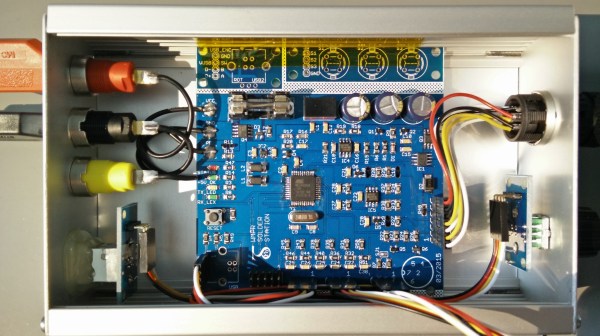Weller, the German soldering tools manufacturer, has a nice range of micro soldering irons (pencils) designated as the WMRP series. These are 12V, 40 W or 55W units with a 3 second heat up time, and allow quick tip exchange without needing any tools. [FlyGlas] built a neat soldering station / controller for the WMRP series based around an ATMega microcontroller running Arduino.
It’s packed with most of the features you see in a professional rig.
- low offset op amp for soldering tip temperature measurement with type c thermocouple
- cold junction compensation using the PTC (KTY82-210) included in the WMRP soldering pencil
- input voltage measurement
- soldering pencil current measurement
- recognizing if the soldering pencil rests in the stand (–> standby)
- 3 buttons to save and recall temperature values
- rotary encoder to set soldering temperature
- illuminated 16×2 character LCD module
- USB for debugging and firmware update
- 4mm safety socket for +12V power input and a protective earth socket for connection to ESD protection
 A PWM signal from the microcontroller controls the load current using a MOSFET. Load current is measured using a Hall Effect-Based Linear Current Sensor – ACS712. The corresponding linear output voltage is buffered and slightly amplified using AD8552 zero drift, single supply, RRIO Dual Op Amp before being sent to the microcontroller ADC input. To ensure ADC measurements are accurate and stable, a low noise precision voltage reference – ADR392 is used. Another precision resistive voltage divider allows input voltage measurement. The supply input has over-current and reverse voltage protection. A set of buttons and a rotary encoder are connected to the microcontroller to allow settings and adjustments. An analog section measures the thermocouple voltage from the soldering pencil as well as the stand-by switch status. The handle has an embedded reed switch that is activated by a magnet in the support stand which puts it into stand-by mode. Another analog section performs cold junction compensation using the PTC sensor within the soldering pencil.
A PWM signal from the microcontroller controls the load current using a MOSFET. Load current is measured using a Hall Effect-Based Linear Current Sensor – ACS712. The corresponding linear output voltage is buffered and slightly amplified using AD8552 zero drift, single supply, RRIO Dual Op Amp before being sent to the microcontroller ADC input. To ensure ADC measurements are accurate and stable, a low noise precision voltage reference – ADR392 is used. Another precision resistive voltage divider allows input voltage measurement. The supply input has over-current and reverse voltage protection. A set of buttons and a rotary encoder are connected to the microcontroller to allow settings and adjustments. An analog section measures the thermocouple voltage from the soldering pencil as well as the stand-by switch status. The handle has an embedded reed switch that is activated by a magnet in the support stand which puts it into stand-by mode. Another analog section performs cold junction compensation using the PTC sensor within the soldering pencil.
The Git repo contains the initial Arduino code which is still a work in progress. While the hardware source files are not available, the repo does have the pdf’s, gerbers and BOM list, if you want to take a shot at building it. Check a demo video after the break. Thanks [Martin] for sending in the tip.
Continue reading “Hacking Amazing Soldering Features Into The Already Great Weller WMRP” →



 A PWM signal from the microcontroller controls the load current using a MOSFET. Load current is measured using a Hall Effect-Based Linear Current Sensor –
A PWM signal from the microcontroller controls the load current using a MOSFET. Load current is measured using a Hall Effect-Based Linear Current Sensor – 










